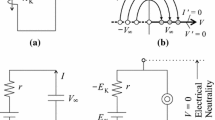Abstract
In order to explore the possibility of identifying toxins based on their effect on the shape of action potentials, we created a computer model of the action potential generation in NG108-15 cells (a neuroblastoma/glioma hybrid cell line). To generate the experimental data for model validation, voltage-dependent sodium, potassium and high-threshold calcium currents, as well as action potentials, were recorded from NG108-15 cells with conventional whole-cell patch-clamp methods. Based on the classic Hodgkin–Huxley formalism and the linear thermodynamic description of the rate constants, ion-channel parameters were estimated using an automatic fitting method. Utilizing the established parameters, action potentials were generated using the Hodgkin–Huxley formalism and were fitted to the recorded action potentials. To demonstrate the applicability of the method for toxin detection and discrimination, the effect of tetrodotoxin (a sodium channel blocker) and tefluthrin (a pyrethroid that is a sodium channel opener) were studied. The two toxins affected the shape of the action potentials differently, and their respective effects were identified based on the predicted changes in the fitted parameters.
Access this chapter
Tax calculation will be finalised at checkout
Purchases are for personal use only
Similar content being viewed by others
References
Gross GW, Harsch A, Rhoades BK et al (1997) Odor, drug and toxin analysis with neuronal networks in vitro: extracellular array recording of network responses. Biosens Bioelectron 12:373–393
Gross GW, Rhoades BK, Azzazy HM et al (1995) The use of neuronal networks on multielectrode arrays as biosensors. Biosens Bioelectron 10:553–567
Morefield SI, Keefer EW, Chapman KD et al (2000) Drug evaluations using neuronal networks cultured on microelectrode arrays. Biosens Bioelectron 15:383–396
Akanda N, Molnar P, Stancescu M et al (2009) Analysis of toxin-induced changes in action potential shape for drug development. J Biomol Screen 14:1228–1235
Amigo JM, Szczepański J, Wajnryb E et al (2003) On the number of states of the neuronal sources. Biosystems 68:57–66
Chiappalone M, Vato A, Tedesco MB et al (2003) Networks of neurons coupled to microelectrode arrays: a neuronal sensory system for pharmacological applications. Biosens Bioelectron 18:627–634
Xia Y, Gopal KV, Gross GW (2003) Differential acute effects of fluoxetine on frontal and auditory cortex networks in vitro. Brain Res 973:151–160
Akay M, Mazza E, Neubauer JA (1998) Non-linear dynamic analysis of hypoxia-induced changes in action potential shape in neurons cultured from the rostral ventrolateral medulla (RVLM). FASEB J 12:2881
Clark RB, Bouchard RA, Salinas-Stefanon E et al (1993) Heterogeneity of action-potential wave-forms and potassium currents in rat ventricle. Cardiovasc Res 27:1795–1799
Djouhri L, Lawson SN (1999) Changes in somatic action potential shape in guinea-pig nociceptive primary afferent neurones during inflammation in vivo. J Physiol 520:565–576
Mohan DK, Molnar P, Hickman JJ (2006) Toxin detection based on action potential shape analysis using a realistic mathematical model of differentiated NG108-15 cells. Biosens Bioelectron 21:1804–1811
Muraki K, Imaizumi Y, Watanabe M (1994) Effects of noradrenaline on membrane currents and action-potential shape in smooth-muscle cells from guinea-pig ureter. J Physiol 481:617–627
Nygren A, Fiset C, Firek L et al (1998) Mathematical model of an adult human atrial cell: the role of K+ currents in repolarization. Circ Res 82:63–81
Bernus O, Wilders R, Zemlin CW et al (2002) A computationally efficient electrophysiological model of human ventricular cells. Am J Physiol Heart Circ Physiol 282:H2296–H2308
Nygren A, Leon LJ, Giles WR (2001) Simulations of the human atrial action potential. Philos Trans R Soc Lond Ser A 359(1783):1111–1125
Winslow RL et al (2001) Computational models of the failing myocyte: relating altered gene expression to cellular function. Philos Trans R Soc Lond Ser A 359:1187–1200
Winslow RL, Cortassa S, Greenstein JL (2005) Using models of the myocyte for functional interpretation of cardiac proteomic data. J Physiol 563:73–81
Hodgkin AL, Huxley AF (1952) A quantitative description of membrane current and its application to conduction and excitation in nerve. J Physiol 117:500–544
Destexhe A, Huguenard JR (2000) Nonlinear thermodynamic models of voltage-dependent currents. J Comput Neurosci 9:259–270
Weiss TF (1996) Cellular biophysics. MIT Press, Cambridge, MA
Kowtha VC, Quong JN, Bryant HJ et al (1993) Comparative electrophysiological properties of NG108-15 cells in serum-containing and serum-free media. Neurosci Lett 164:129–133
Ma W, Pancrazio JJ, Coulombe M et al (1998) Neuronal and glial epitopes and transmitter-synthesizing enzymes appear in parallel with membrane excitability during neuroblastoma x glioma hybrid differentiation. Dev Brain Res 106:155–163
Molnar P, Kang J-F, Bhargava N, Das M, Hickman JJ (2007) Synaptic connectivity in engineered neuronal networks. Patch-clamp methods and protocols. Humana, Totowa, NJ, pp 165–173
Acknowledgements
This work was supported by NIH Career Award K01 EB03465 and DOE grant DE-FG02-04ER46171.
Author information
Authors and Affiliations
Corresponding author
Editor information
Editors and Affiliations
Rights and permissions
Copyright information
© 2014 Springer Science+Business Media New York
About this protocol
Cite this protocol
Molnar, P., Hickman, J.J. (2014). Modeling of Action Potential Generation in NG108-15 Cells. In: Martina, M., Taverna, S. (eds) Patch-Clamp Methods and Protocols. Methods in Molecular Biology, vol 1183. Humana Press, New York, NY. https://doi.org/10.1007/978-1-4939-1096-0_16
Download citation
DOI: https://doi.org/10.1007/978-1-4939-1096-0_16
Published:
Publisher Name: Humana Press, New York, NY
Print ISBN: 978-1-4939-1095-3
Online ISBN: 978-1-4939-1096-0
eBook Packages: Springer Protocols




